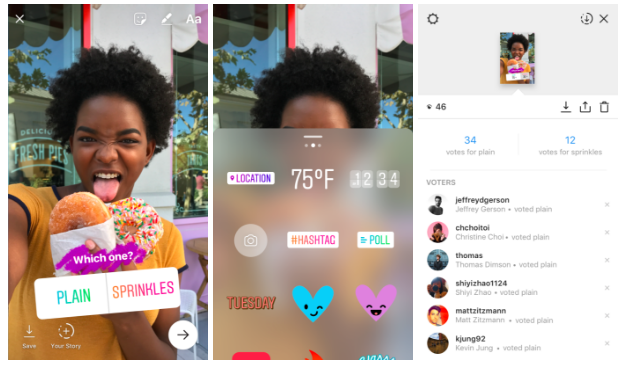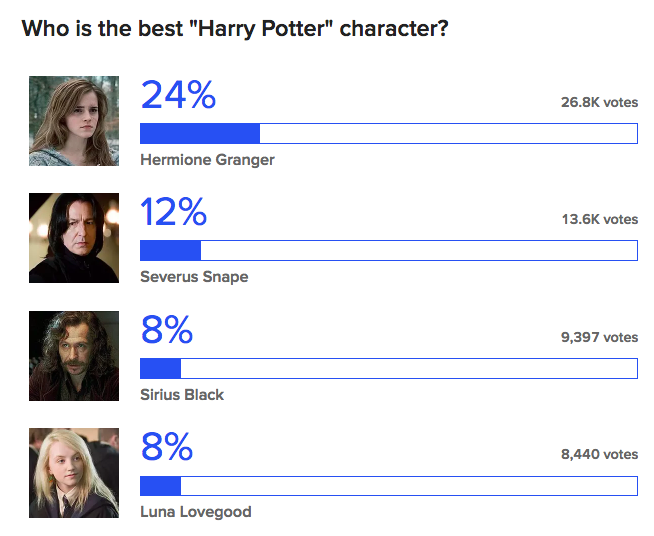For Google News
The Marketing Magic of Social Media Polls
By Krystal Overmyer on April 9, 2018
Do you like polls? Or do you really like polls?
Thanks to social media polls, getting feedback from your audience on questions like these is easier than ever. Twitter got on the bandwagon early on; more recently, Instagram has made polling even more visual and interactive by adding the option to its Stories feature.
Eliciting and incorporating consumer feedback has always been important to marketers, and surveys, polls, and voting can drive excitement. What's interesting about polls on social media is how they make capturing data and engaging users so intimate and immediate. On Instagram Stories, for example, users can get feedback on what outfit to wear or where to go to dinner in a matter of seconds. Take a photo or video, add the two-option poll, share, and immediately start seeing results in real-time. The results continuously update, so followers can keep checking back to see the latest results.
It seems polls are having a bit of a moment on social media. Twitter, Facebook, and Instagram have polling options; on Snapchat, social polling app Polly is a hit among teens. No doubt you've already seen examples of polling in action from influencers, friends, and even a brand or two.
Why Polls Fascinate Us
Here's a bit of '90s trivia for you: Before 1995, blue M&M'S didn't exist. Instead of blue, we had tan M&M'S. But by 1995, Mars was ready to switch things up.
In a brilliant move, the company gave the decision to the public. Candy lovers could call a 1-800 number to vote for either blue, pink, or purple to replace tan. By the time the two-month campaign ended, 10 million votes had been cast. The winner? Blue, with 54 percent of the vote.
The successful M&M'S voting phenomenon demonstrates just how much we love polls and voting. Tens of millions of us vote for our favorite American Idol. We rabidly follow political polls to glean insight into the future. We fill out BuzzFeed polls ranking the best Harry Potter character. We rock the vote around election time (some of us, anyway).
Why are we so fascinated with polls? Polls and surveys allow people to express their opinions and be part of the conversation. Moreover, people are curious about how their views line up with the rest of the world. (Who knew there were so many other Severus Snape fans out there?)
While M&M'S relied on the old-fashioned telephone to engage the public, today's brands have it easier. Social polls have made it possible to interact with consumers in an instant. With the poll feature on Instagram Stories, audience interaction is a mere tap away.
While many brands and influencers are using social media polls to drive audience engagement-with "do you like this or that?" style polls-the brilliant part of this tool is its ability to go beyond mere engagement. Brands can use polls to understand their customers' needs, interests, and opinions, which can affect product strategy, branding, messaging, and beyond.
How to Utilize Social Media Polls
There are plenty of ways to use polls to your brand's advantage. Consider the following ideas:
Make ’Em Laugh
If humor is a good fit for your brand and audience, polls can be a great way to crack a joke. Make the question silly, or make the options snarky to get your audience to chuckle. Ever the leader on polls, M&M'S went a bit whimsical with a poll aimed at capturing the inner psychology of followers.
#myspiritanimalwould be...
- M&M'S® Brand (@mmschocolate) February 13, 2018
On Facebook, Dollar Shave Club created "Mirch Madness" polls asking users to vote on how to prank "Club Pro Ken Mirch" with its products. No stranger to humor, the brand used the prank gimmick to highlight Dollar Shave Club products while inviting the audience to join the fun.
Engage through Choice
Millions voted for the next M&M because they wanted to be a part of a pretty historic event. When brands ask users to get involved in their decision-making process, they show fans they care about their input. And fans love expressing their opinions to brands they enjoy.
For example, Metallica revved up audience engagement during their 2014 tour, when they left almost the entirety of their set lists up to fans. Ticketholders chose 17 of the 18 songs the band played at its concerts that year.
Influencers use Instagram polls in subtler but no less engaging ways. The fashionista might ask for input on how to style her outfit of the day; the travel blogger might ask what new destination to visit. Polls make it possible for interaction with the influencer or brand to be quick, informal, and immediate.
Of course, leaving decisions up to society at large can backfire. When Britain's Natural Environment Research Council invited the public to christen its polar research ship, the name "Boaty McBoatface" won handily with over 124,000 votes. Embarrassed officials had to reject the people's choice-although the organization did compromise by giving the name to an unmanned submarine. Limiting the options available to your audience can help reduce the risk of a poll going awry.
Inform and Entertain
Polls can also be deployed to deliver information in a unique and interactive way. The Academy Awards used Twitter polls in a quiz-style format to deliver fun facts and audience engagement on a night when people are glued to both the TV screen and their mobile devices.
What Oscar nominee also received an Honorary Award this year? #OscarsPopQuiz https://t.co/IaDYjzqXuZ
- The Academy (@TheAcademy) March 4, 2018
Similarly, TurboTax's true/false poll aims to encourage engagement on the platform and also drive traffic to the brand's website. By piquing user curiosity through an interesting question, the brand creates a powerful recipe to nudge people off Twitter and onto their owned content.
After you complete 30 rideshares, you’re considered #SelfEmployed.
- TurboTax (@turbotax) February 24, 2018
Microsoft Education took a conversation-starting approach with a poll to spur comments on STEM education. By working to generate conversation on an important topic, the brand presents itself as an expert in the field.
Our next #MSFTEduChat on 3/20 will be all about #WomeninSTEM. Which factor do you think will most improve girls’ sustained interest in #STEM education? Please vote and reply!
- Microsoft Education (@MicrosoftEDU) March 16, 2018
Conduct Research and Generate Ideas
Instead of wondering what your audience needs or wants, social media polls open up a new option: Just ask.
On Instagram, the Washington Post asked users to rate the value of its news recap feature. By asking users how they feel about the content, the publisher gets a sense of whether it should tweak the format or produce more of the same.
Password manager LastPass queried users about the features they like best about its software.
Which LastPass feature is most important to you?
- LastPass (@LastPass) July 26, 2017
Polls can also drive content. Starbucks asked customers what brewing method they wanted to learn about, coffee press or chemex. The ensuing vote triggered more content about the winning method, the coffee press. When commenters asked for more details about other brewing methods, the company had links to content readily available.
Let's talk coffee! ☕️ Which at-home brewing method are you interested in learning about?
- Starbucks Coffee (@Starbucks) March 20, 2018
Surprisingly, many brands have never used a poll on any social media platform. With so many ways to use polls, brands that skip the option are missing out on an opportunity to boost audience interaction while gaining valuable information about their fans. Social polls are still new enough that there's room for brands to use them to break through the noise and encourage users to linger a few seconds more to ponder the content. With users bombarded with so much information daily, those few extra seconds can make all the difference.
For more stories like this, subscribe to the Content Standard newsletter.
Featured image attribution: Bruce Mars





